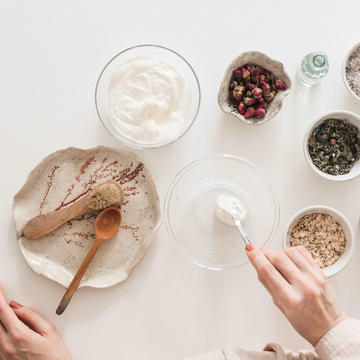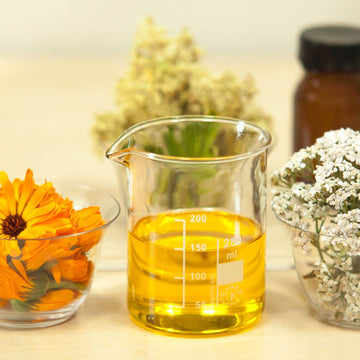The Healing Powers of Ayurvedic Ingredients: Turmeric, Sandalwood, and Neem
Introduction
Ayurveda, the ancient holistic healing system from India, emphasizes the use of natural ingredients to promote balance and harmony within the body and skin. Unlike conventional skincare products that often contain synthetic chemicals, Ayurvedic skincare relies on the healing powers of botanicals to address the root causes of skin concerns and maintain overall wellness. Today, we delve into three powerful Ayurvedic ingredients—turmeric, sandalwood, and neem—to explore their unique benefits and how they can help balance your doshas, enhance your skin, and promote inner and outer health.
Turmeric: The Golden Healer
Turmeric, often referred to as the "Golden Goddess," is a cornerstone of Ayurvedic medicine and skincare. Known for its vibrant yellow color and earthy aroma, turmeric is a powerful botanical that offers numerous benefits for the skin and body.
Benefits of Turmeric in Ayurveda:
- Anti-Inflammatory Properties: Turmeric is renowned for its potent anti-inflammatory effects, thanks to its active compound, curcumin. This makes it an excellent remedy for calming inflamed skin, reducing redness, and soothing conditions like eczema and acne.
- Balancing the Pitta Dosha: In Ayurveda, turmeric is used to balance the Pitta dosha, which governs heat and metabolism in the body. An excess of Pitta can manifest as skin irritations, inflammation, and sensitivity. Turmeric’s cooling properties help to pacify Pitta, restoring balance and calm to the skin.
- Antioxidant Powerhouse: Rich in antioxidants, turmeric protects the skin from free radicals and environmental stressors, which can cause premature aging. It helps to brighten the complexion and improve skin tone, giving you a radiant glow.
How to Incorporate Turmeric into Your Routine:
- Facial Mask: Mix turmeric powder with yogurt or honey to create a soothing face mask that helps brighten the skin and reduce inflammation. Apply once or twice a week for best results.
- Turmeric Tea: Enjoy a cup of turmeric tea to support skin health from within. This warm, golden drink helps detoxify the body and promote overall wellness.
Sandalwood: The Calming Balm
Sandalwood is another cherished ingredient in Ayurveda, celebrated for its soothing and balancing effects on both the skin and mind. With its distinctive woody scent and cooling properties, sandalwood has been used for centuries in Ayurvedic rituals and skincare practices.
Benefits of Sandalwood in Ayurveda:
- Soothing for All Doshas: Sandalwood is unique in its ability to balance all three doshas—Vata, Pitta, and Kapha. Its cooling and calming properties make it particularly effective for reducing excess heat (Pitta) and calming the mind and body.
- Calming and Anti-Inflammatory: Sandalwood is known for its anti-inflammatory and antiseptic properties, which help to soothe irritated skin, reduce redness, and calm conditions like acne and rashes.
- Natural Astringent: Sandalwood acts as a natural astringent, helping to tighten the skin and reduce the appearance of pores. This makes it an excellent choice for those looking to achieve a smooth, even complexion.
How to Incorporate Sandalwood into Your Routine:
- Sandalwood Paste: Mix sandalwood powder with a little rose water to create a paste. Apply to the face as a natural toner to cool and soothe the skin, balance oil production, and promote an even skin tone.
- Aromatherapy: Use sandalwood essential oil in a diffuser to create a calming environment. Its soothing scent helps reduce stress and anxiety, promoting relaxation and mental clarity.
Neem: The Purifying Powerhouse
Neem, often called “Nature’s Pharmacy,” is a powerful herb in Ayurveda known for its detoxifying and purifying properties. This versatile ingredient is widely used in Ayurvedic skincare for its ability to address a range of skin concerns, from acne to dryness.
Benefits of Neem in Ayurveda:
- Detoxifying and Purifying: Neem is revered for its ability to detoxify and purify the skin, making it an ideal ingredient for cleansing and preventing breakouts. It helps to remove impurities and excess oil, keeping the skin clear and balanced.
- Balancing the Kapha Dosha: Neem is particularly effective for balancing the Kapha dosha, which is associated with oiliness and congestion in the skin. By regulating sebum production and preventing clogged pores, neem helps maintain a healthy, clear complexion.
- Antibacterial and Antifungal Properties: Neem’s natural antibacterial and antifungal properties make it a powerful ally in fighting acne-causing bacteria and soothing irritated skin. It also helps to prevent and treat fungal infections, keeping the skin healthy and vibrant.
How to Incorporate Neem into Your Routine:
- Neem Face Wash: Use a gentle neem-based face wash to cleanse the skin and prevent breakouts. Its purifying properties help keep the skin clear and healthy.
- Neem Infused Water: Boil neem leaves in water, cool, and use it to rinse your face. This natural toner helps balance oil production and maintain clear, glowing skin.
Conclusion
Ayurvedic skincare is a holistic approach that emphasizes balance, harmony, and the use of natural ingredients to enhance the skin's natural beauty. Turmeric, sandalwood, and neem are just a few of the powerful botanicals used in Ayurveda to support skin health and well-being. By incorporating these ingredients into your daily routine, you can harness their healing powers to achieve a radiant, balanced complexion.
Ready to explore more about Ayurvedic practices and how they can transform your skincare routine? Follow Rooh Beauty for daily tips and insights into natural skincare and holistic wellness. Embrace the journey to balanced, glowing skin with Ayurveda!




